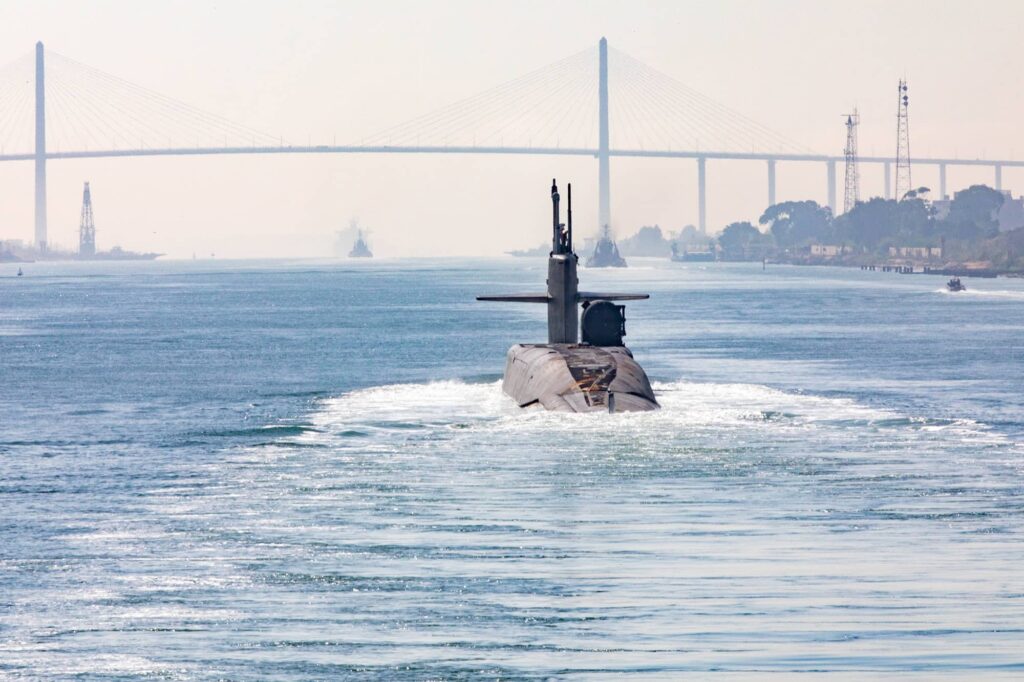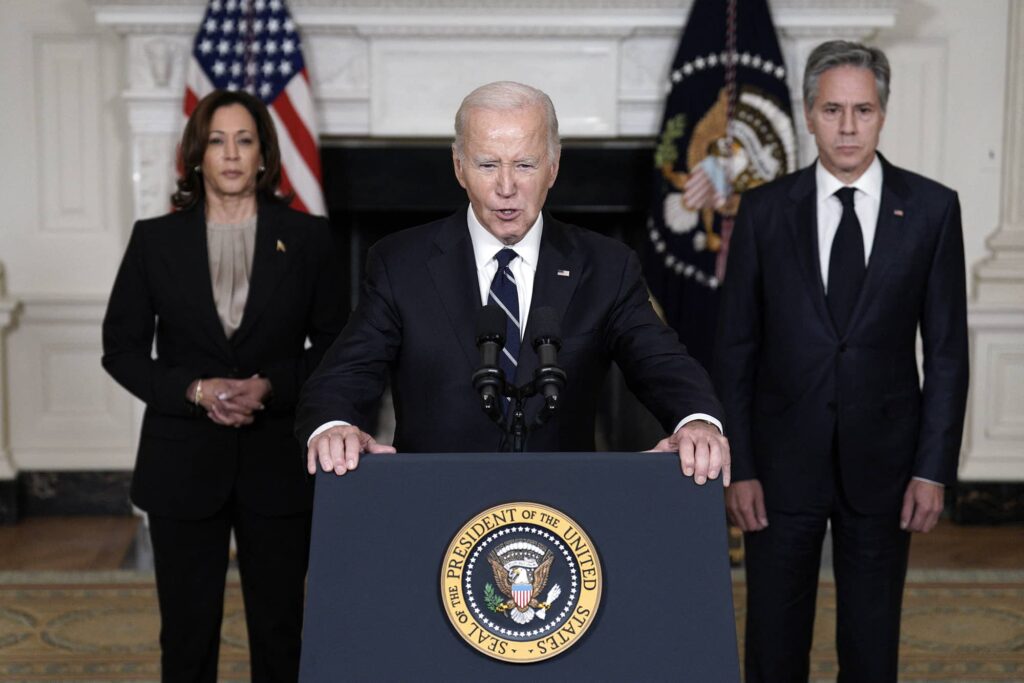The profound strategic implications of the American support for Israel in the war against Hamas – including a significant US military deployment to the region (two Carrier Strike Forces and an Ohio-class nuclear submarine, as well as air assets), albeit for the purpose of deterrence rather than participation in the fighting – will fully manifest themselves only over time. Among the implications of this new American military role is the open possibility that it will also lead to a comprehensive change of paradigm regarding Iran and its proxies in the region, with all that this would entail.
A Break With the Past
“There is only one thing worse than fighting with allies,” Winston Churchill famously said, “and that is fighting without them.” For Israel, this has been a forgotten truism. A longstanding element of Israel’s defense doctrine is that Israel defends itself by itself.
There have always been exceptions. In 1956, three squadrons of the French air force – 54 fighters in all – were deployed to Israeli bases at the request of Prime Minister David Ben-Gurion. They defended Israel’s airspace during the Sinai campaign, freeing the country’s young air force to support the ground forces in Sinai battling the Egyptians.
Since the 1960’s Israel has also relied on American arms supply, including an airlift during the last stages of the 1973 War, with Israel eventually becoming the largest recipient of American foreign military financing. Patriot missile defense batteries were deployed to Israel during the Gulf War of 1991 (and again in 2003) to help defend against Saddam’s missiles, but this was done, at the time, in order to dissuade Israel from joining the fray. And a small American contingent has been manning for more than 15 years a facility in the Negev, housing an X-Band Radar (AN/TPY-2) which supports Israel’s early warning capacity against a long-range missile attack.
Unlike America’s European allies, Japan, or South Korea, however, Israel has not relied on large-scale American forces.
The attack of October 7 may have changed the US-Israel defense relationship. Before the day was over, President Biden made the unprecedented decision to back Israel not only by a rapidly organized line of supplies but also by the presence in the Eastern Mediterranean of the Gerald R. Ford Carrier Strike Group. Another CSG – that of the Eisenhower – was later deployed to the Persian Gulf, and an Ohio class nuclear submarine, Florida, was also announced to be in the region. All this lent weight to the overt deterrent message to both Hizbullah and Iran, “don’t.”
In addition to the carriers – the traditional tool of American power projection – significant US Air Force and air defense assets were also deployed to the region, as well as other components of the force protection envelope needed to secure US bases in Syria, Jordan, Iraq and the Gulf. The Amphibious Ready Group of the USS Bataan – with a history of being the first US military asset to be deployed to the region following 9/11 – later sailed up the Red Sea, in response to the launches from Houthi-held Yemen. In early November, the Florida was officially announced to be operating in the Middle East, despite the traditional reluctance to report the whereabouts of US submarines. In all, this amounts to a show of force unprecedented in the history of American backing for Israel.
Israel did not have much of a choice in the matter. The IDF was busy mobilizing its reserve formations to be deployed both south and north. Hundreds of thousands were on the move to their units, liable to be caught by an attack on the roads and on their cities and towns. The need was paramount to dissuade Hizbullah from opening a second front immediately.

What Drove Biden’s Decision?
Why did Biden, very early on, take these dramatic steps? Several powerful factors apparently came together and, as has often been the case in history, there was the personal gut reaction of the President himself. Within hours of the attack he was aware of the scope and nature of Hamas’ atrocities, and given his own background and the strength of his affinity with Israel, he understood that an extraordinary reaction would be called for. He gave a stark expression to his feelings on the very first day, and translated it, there and then, into a warning to Israel’s other enemies not to join the fray.
The administration apparently came to the conclusion early on that the Iranian regime was complicit in the Hamas assault. More significantly, the prospect of further action by Iran and its proxies seemed real enough in the immediate aftermath of Hamas’ tactical success. This meant, in turn, that nothing short of a quick and robust American response would probably suffice to avert a large-scale escalation and expansion of the conflict. This was also the concern expressed by the key allies in Europe – Germany, Britain, France and Italy – whose leaders joined Biden in a five-power statement repeating the same warning to Iranian proxies and Iran itself.
Such proxy action did materialize, first against Israel and then against American military targets, with Iran orchestrating the action, as described by Ehud Yaari. Hizbullah slowly increased their localized attacks, losing dozens of their men trying to launch anti-tank missiles against Israeli targets. A few Israelis were killed in the early days but then the means of detection improved, and most if not all Hizbullah anti-tank squads were destroyed. Hizbullah’s leader, Hasan Nasrallah, took care during the first four weeks not to cross the threshold over into full-scale warfare, with the American deterrent posture playing a role, The possibility of escalation was left open, however.
The Houthi regime in Yemen then joined the fray, with a number of long-range missile and drone attacks aimed at Israel’s southern port city of Eilat (which now hosts tens of thousands of evacuees from the Gaza and Lebanon border areas). Four missiles of the first salvo were reportedly intercepted by the destroyer USS Carney, stationed in the Red Sea; the fifth was apparently intercepted by a US-supplied Saudi Patriot missile defense system, in effect, lending substance to the concept of an informal “Middle East Air Defense Treaty Organization” that CENTCOM have been working to put together in recent years. Later attempts to fire ballistic missiles and drones at Eilat were foiled by Israel’s Arrow 2 – the first successful interception of a long-range ballistic missile – and by the Israeli Air force.
Meanwhile, dozens of attacks on American military targets took place in both Syria and Iraq, carried out by local militias allied with Iran. In two incidents in Syria, more that 40 American soldiers were reportedly wounded and one contractor killed. The US Air Force retaliated against Iranian Revolutionary Guards Corps targets on 27 October. At least at the rhetorical level, this has given rise to further threats to rid Iraq of the American presence, and continued rocket attacks on the US military bases in eastern Syria.
The American role in the conflict is thus no longer confined to a show of force, and the need for force protection measures to be taken by the US military played a role in delaying the Israeli ground campaign in Gaza by a few days.
An additional factor has been the significance of the war in the broader global and political context. As President Biden made clear in his address to the nation on October 20, this escalation in the region, and specifically the Hamas assault on Israel, should be read in the context of the ongoing war in Ukraine.
Biden’s pairing of Ukraine and Israel was also a political act, in preparation for the submission to Congress of an extensive supplemental budgetary request for both countries – 44.3 billion dollars for Ukraine, 14.3 billion for Israel. This was presented with the full knowledge that the Republicans in the House of Representatives were expected to be torn between their support for Israel and their growing dislike towards the massive support for Ukraine, which the Republicans had rejected in a previous budget measure.
Finally, and much less overtly, another consideration which may have been at work right from the beginning, and seems to be growing in importance, is the Biden administration’s mistrust of the Netanyahu government. This applies first of all to Netanyahu’s ability to conduct the war. The American presence in war cabinet discussions is unprecedented. Secretary of Defense Austin has given due weight to Israel’s anger (Minister of Defense Gallant publicly said that Austin told him he found the Hamas atrocities worse than those of ISIS) and the purpose of dismantling Hamas. But the US is clearly weighing in on Israeli decisions. This may have influenced Netanyahu’s decision not to use the opportunity to open up a second front in the north in the early days of the war.
At the same time, the American presence in Israeli decision-making is also aimed at restraining Israel’s present government’s ultimate goals – given that the government contains strong elements within it whose vision of the future of the Palestinians is starkly at odds with that of the Biden administration and its European and Arab allies. Having been there for Israel at the hour of need, America – now as in 1973 – has carved for itself a central role in preparing for the day after.

Implications of the Expanded American Military Role
Beyond the solace Israelis drew from Biden’s moral stance, the most significant aspect of the American support – in the eyes of Israel’s defense establishment, as it rallied from the disastrous failure of 7 October – was the speed with which their American counterparts responded. By October 8, the first planeload of supplies, including interceptors for the Iron Dome batteries, was on their way. The tight web of communications, operational protocols, and joint exercises woven with CENTCOM since Israel joined was swiftly translated into action.
Israeli decisions now have to take into account American constraints and imperatives, including those below.
- American concerns apparently played a role in Netanyahu’s decision not to launch a preemptive strike against Hizbullah in Lebanon.
- The timing of the ground incursion in Gaza was delayed by a few days, among other reasons – as already indicated – to give the US military the time needed to deploy force protection measures across the region.
- The persistent American demand for humanitarian relief and a corridor into Gaza raised the ire of the Israeli public, given the manner in which the hostages are held, against all humanitarian norms. While the IDF is also interested in humanitarian relief arrangements in the south of Gaza – so as to draw as many civilians as possible away from the battle zones in the northern segment – the perception has taken hold that these gestures are all due to US pressure.
- American involvement in the hostage negotiations (and the President’s call for a “humanitarian pause” to facilitate their release) is also placing some constraint on Israeli actions – and raises the troubling prospect of selective releases by Hamas, aimed at driving a wedge between the US and Israel.
- To the dismay of elements within the Israeli political coalition, the American authorities continue to monitor events in the West Bank, and to ask Israel to curb settler violence against Palestinians. US expectations were also evident in the bitter debate in the Israeli cabinet over the release of tax funds to the Palestinian Authority.
- “Hard questions” asked by the Biden Administration are beginning to shape the debate on “the day after”. The US is in practice positioning itself as a guide and mentor to the Israeli government. Almost by definition, the American position on this set of extremely challenging issues will have to be taken into account as Israel weighs its options.
How will this level of American involvement modify Israel’s deterrence in the region? And what will be the political fallout in Israel in what promises to be a turbulent era of change after the fighting dies down? Will the new military relationship bring Israel into closer association with the US orientation against Russia and China, and will it bring the Biden administration into alignment with Israel (and others in the region) facing the Iranian threat? Much will depend on American political dynamics and a contentious presidential election in 2024.



